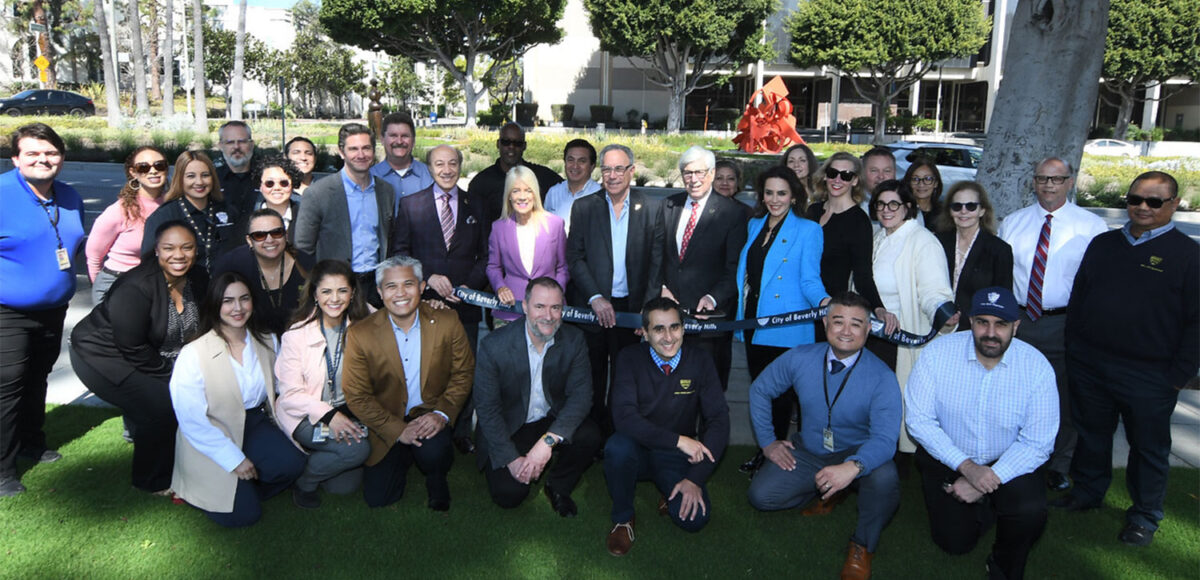Before cutting the ribbon on the Burton Way Green Street and Water Efficient Landscape Project, Mayor Dr. Julian Gold recounted the history of the region’s wastewater system. The new project replaces the grass on the Burton Way median with contemporary sculptures, native plants and technologies to clean and preserve rainwater.
Built in the 1930s by the U.S. Army Corps of Engineers, it was designed to save farmland that dominated the landscape by funneling stormwater into the ocean, Gold said during the Feb. 28 ceremony at Rexford Mini Park.
Now, the Burton Way project will reduce the amount of water and contaminants that flow from Beverly Hills into the sea.
“Who would have thought that almost 100 years later, dumping water in the ocean is probably not something we really want to do,” Gold said. “This entire median really represents … a big step forward in our ability to be sustainable.”
Running along Burton Way from Rexford Drive to Oakhurst Drive, the project saves and treats water through a combination of storm drains and bioswales—vegetated ditches that collect water—which lead to an approximately 1-million-gallon reservoir, Environmental Compliance and Sustainability Program Manager Josette Descalzo said.
Descalzo explained that the storm drains pump stormwater runoff from the street up to the surface of the median, where it then flows into two 15-foot-wide bioswales. The bioswales remove metals, bacteria and organic materials from the water, which is then diverted into the reservoir until is used to irrigate the median.
“I like this project … because of all the pollutants that will be prevented from going to Ballona Creek [which drains into Santa Monica Bay],” Project Manager Tristan Malabanan said. “It’s a huge amount of nuisance water that will be cleaned up and really not making its way to the ocean.”
The project is expected to save 5 million gallons of water a year, and it has already captured more than 1 million gallons since December, even though the storm drains are not up and running, Malabanan said. Staff are still testing the drainage control system and awaiting certification from the pump manufacturers to operate, though rain that has fallen into the bioswales has been collected, he said.
“I don’t think we lose out on one drop of rain that falls in the median,” he added.
Malabanan expects the storm drain systems to be fully operational within the next few weeks, though staff will continue to finetune the system over the coming months, he said.
According to a project background on the city’s website, the project took root roughly a decade ago, when a 2015 drought prompted state officials to implement regulations that prohibited the city from watering the turf lawn that then covered the median.
In 2016, Beverly Hills and other cities comprising the Ballona Creek Watershed adopted the Enhanced Watershed Management Plan (EWMP), which provided a framework for improving water quality in line with the Federal Clean Water Act.
Constructing “green streets” was one of Beverly Hills’ key strategies for accomplishing its EWMP goals, and when the median’s turf lawn started to deteriorate from the state’s watering restrictions, Burton Way emerged as an opportunity to test this approach.
“We developed this multibenefit concept of having a stormwater function and also water efficient landscape functions,” Malabanan said.
The contract was awarded in June 2021, and construction began later that year, though it was no easy feat, Public Works Assistant Director/City Engineer Daren Grilley said.
Installing the 1.2-million-gallon reservoir approximately 30 feet underground “was very impactful on the community,” securing special permits from the U.S. Army Corps of Engineers was “a lengthy process,” and pandemic-era supply chain issues and heavy storms in 2022 and 2023 further slowed the project, Malabanan said.
In total, the project cost $12 million, with nearly $7 million coming from state and county sources, including the Safe Clean Water Program, also known as Measure W, according to Gold.
“This is the result of many years of planning and designing and construction finally coming to an end, and the results are out there for people to see,” Grilley said. “It feels great.”
Not all residents are pleased.
Following the ribbon-cutting ceremony, architect Tom Roberts said that while he appreciates the water quality and reduction benefits, he dislikes the aesthetics of the landscaped median, taking specific issue with the amount of grass that was removed to install the bioswales.
In an interview, Gold said that everyone he’s spoken to has been happy with the project, though he acknowledged that it is just one part of the city’s broader water quality plans.
Under the EWMP, the city will need to construct enough green streets to capture approximately 12.7 million gallons of “urban runoff per rain event to preserve the health of the watershed,” according to the website.
Projects like the Burton Way Green Street are expensive and land intensive, Gold said. Though no others are being planned, the city had previously considered a catchment system underneath La Cienega Park, and building a green street near the Cabrillo Reservoir remains a possibility, he added.
“This is not the totality of it,” Gold said. “It’s really just the beginning.”







